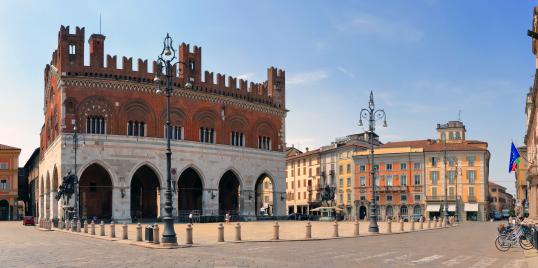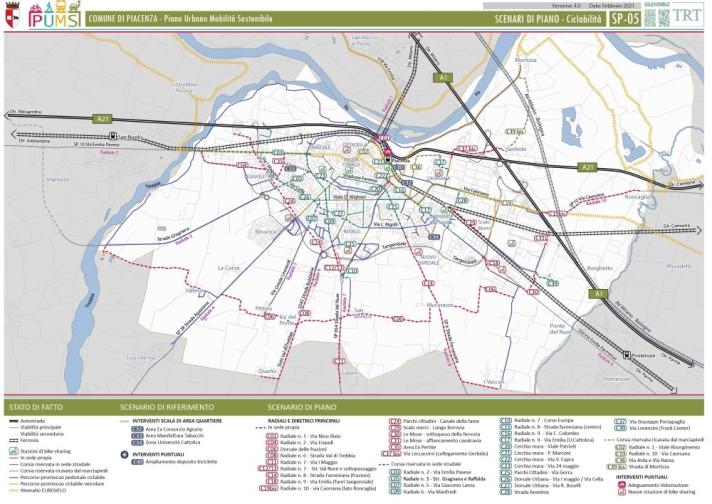- Topic
- Urban mobility planning
- Country
- Italy
- Resource type
- Case study
First published on 18 August 2021.
In 2018, the Municipality of Piacenza (Italy) started the process of drafting its Sustainable Urban Mobility Plan (SUMP) and Urban Transport Plan (UTP). Subsequently, during 2020, a ‘Plan for Cycling Mobility’ was added to complement the SUMP’s principles and initiatives. The SUMP was developed in a way that was consistent with the European Guidelines for Developing and Implementing a Sustainable Urban Mobility Plan (2nd edition-2019) and the national guidelines issued by the Italian Ministry of Transport (Decree 4 August 2017 and integrations in Decree 28 August 2019). The consultancy firm TRT Trasporti e Territorio was selected to support the Municipality in this planning process.
In December 2020, after almost 2 years of intensive work and active public involvement, Piacenza’s SUMP was approved by the City Council. The UTP is to be approved by the end of 2021, while the Plan for Cycling Mobility is at an earlier drafting stage.
As a result of a strategic and sustainable approach, urban mobility in the city will be developed through a harmonised and holistic set of actions that can be put in place during the next 10 years to meet the mobility needs and cope with the mobility issues of the city. The SUMP is an interesting example of coordination not only between different mobility planning instruments, but also with other urban or environmental planning aspects. Moreover, what is relevant is the constant interaction between long-term and short-term actions, as well as strategies and implementation.
Context
The city of Piacenza has a population of approximately 102,000 people and is one of the main cities of the Emilia Romagna Region in northern Italy. It is the capital city of a wider administrative unit (province). Therefore, it represents a hub that serves many small municipalities in the vast territory of the Apennine Mountains’ valley. It is a compact city located along the Po River Valley, between the mouths of River Trebbia and the River Nure. The Apennine Mountains are only a few kilometres to the south. For these reasons, it is a place surrounded by great landscapes but, at the same time, it is one of the most critical areas in Europe in terms of air quality.
The particular geographical position and the connection with major communication routes make the city an important hub for road and rail freight flows, and a suitable place for logistics activities. Indeed, the city is situated at a major crossroads at the intersection of Route E35/A1 between Bologna and Milan, and Route E70/A21 between Brescia and Turin. It is also an important railway junction along the Milan-Bologna high-speed railway line.
Sustainable transport modes account for a significant amount of the city's modal share. In fact, 47% of trips done by workers and students inside the municipal territory are undertaken sustainably (20% of trips are made on foot, 18% by bike and 9% by public transport). Yet, around 53% of trips are still made by private motorised vehicles and car ownership, which stands at 620 per 1000 inhabitants, continues to grow. In addition, the local and regional administrations are very keen to improve the quality of life and to promote sustainable mobility behaviour. In fact, the city was recognised in each of the last 3 years as a ‘cycling city’ by the Italian Federation of the Environment and Bicycle, which assesses the level of cycling in the Italian municipalities.
In action
The SUMP establishes a harmonised set of actions that aim to implement a sustainable vision and define a path to follow to improve Piacenza’s urban mobility in the next decade. It is structured in a set of short-medium (2 to 5 years) and long (10 years) term actions. The short-term measures identified in the SUMP were further elaborated and detailed within the UTP, which in its nature is more technical and operational. Similarly, the Plan for Cycling Mobility is going to consider and further develop all cycling strategies and measures included in the SUMP.
The guiding vision of the SUMP is based on the concept of sustainability, to be achieved through a combination of policies, infrastructure, soft-interventions and tools that are consistent with a common and shared vision for the city. The SUMP defines measures for all mobility-related aspects including walking, cycling, public transport, public space, urban logistics, parking and innovative options.
The planning process was organised using the following steps:
- Analysing the local mobility system and planning context. This analysis was based on the use of different open-data sources, additional data collected and provided by the municipality, and the regional government. In addition, insights from city users and stakeholders were obtained during an extensive participatory process. Ad-hoc mobility surveys and traffic counts were also carried out to develop and calibrate the transport model.
- Evaluating the current scenario and defining general and specific planning objectives and indicators. This was done considering environmental, social and economic impact; and mobility-related aspects.
- Drafting the SUMP, assessment and quantification of resources and definition of the monitoring system. The SUMP included the identification of two possible scenarios:
- Reference Scenario (or business as usual), which included those measures that were already planned and that would have happened even if the SUMP was not implemented.
- Future Scenario, including all measures proposed for the next 10 years to improve all transport modes in an integrated manner. This included an action plan, a clear allocation of responsibilities and an outline of the required resources.
- Adopting and approving the SUMP. Regulated by the national law, this process foresees the adoption of the plan and a 60-day period to collect final observations from inhabitants, economic operators and organisations (and any objections they may have). Every observation had to be approached individually and, when applicable, modifications were included in the original plan. Once this period was finished, the SUMP was ready to be approved by the City Council.
In parallel to all four phases, a transport simulation tool was applied for the technical, environmental and economic assessment, and then a well-structured participatory process was put in place.
A transport simulation tool, PTV VISUM®, was used for the evaluation process. PTV VISUM® is sophisticated multimodal transport software that is widely used for analysing and planning urban mobility demand and supply interaction. It was used to estimate the impact generated by the measures included in the different scenarios: Base (Year 0), Reference (Year 10, including already planned measures) and Future Scenario (Year 10, including additional measures). It included the simulation of private motorised transport and public transport flows; and cycling and walking. It also included different intermodal choices such as park & ride and bike & ride schemes.
The participatory process, which was more qualitative in nature, helped to understand stakeholders’ and city users’ perspectives, needs and interests at every planning phase. During the analysis, it enabled planners to recognise the strengths and weaknesses of the mobility system. Next, it facilitated the gathering of ideas and insight from stakeholders, which were valuable inputs for the drafting of the scenarios. Finally, it helped to improve the public’s acceptability and the suitability of the SUMP by fine-tuning some controversial or sensitive issues.
The participatory process included a survey, which took place between November 2018 and January 2019. It was designed to identify the needs and priorities of the local community with respect to the mobility system. The survey could be completed online (hosted on the City Council’s website) or on paper (at dedicated and strategically located stands at the city hall and the central railway station). Approximately 900 people responded.
The next phase involved further listening to the local community. This was achieved through an institutional meeting dedicated to stakeholders and city users to debate the current status of urban mobility, and to discover the mobility attitudes and perceptions of the participants. The meeting took place in February 2019 and was structured in four thematic sessions:
- use of public space and street safety: implementing the ‘zero vision’ (that is, eliminating road casualties and improving the sustainability of the mobility system);
- walking and cycling: enhancing existing cycle infrastructure and completing the cycle and pedestrian network (including related services);
- urban logistics: transport of goods in urban areas and regulations (such as access criteria, facilities, technologies and support services);
- public transport and sharing services: improving the public transport network and services in terms of accessibility and quality.
In June 2019, there were additional opportunities for consultation as a result of the organisation of three territorial focus groups. A first draft proposal of the SUMP was presented in three different meetings that took place in three different areas of the city (Centre, South East and South West). This was done to encourage the greater participation of people from different parts of the city and to better focus on territorial aspects.
All these meetings provided inputs for defining the objectives, strategies and scenarios of the SUMP. The participatory approach adopted by the planners and decision makers was an essential element in identifying challenges, and selecting the planning strategies and packages of measures.
In addition, and in line with the Italian SUMP guidelines and as requested by the Emilia Romagna Region, the SUMP was accompanied by a Strategic Environmental Assessment. This is a procedure that aims to guarantee a high-level of environmental protection and sustainable development, and accompanies the planning process in all its phases. This is, indeed, an added value of the Italian SUMP regulations.
In December 2019, the proposal for the SUMP was presented to the Council Commission and the Territory and Economic Development Council. In January 2020, it was adopted prior to the 60-day observation period (phase 4 above). However, the coronavirus (COVID-19) pandemic during 2020 brought many unexpected delays to the process. Observations were frozen for several months and were only reviewed in October 2020.
A new updating phase was initiated to include in the planning documents the initiatives that were put in place at national, regional and municipal levels to help mitigate the risks associated with the COVID-19 emergency during the course of 2020. Only at this point were all observations considered and, on 30 December 2020, the final and updated version of the SUMP was approved by the City Council.
In the meantime, and in parallel to phases 3 and 4, the UTP was developed to define, at a higher level of detail, the SUMP’s short-term actions to enable their immediate implementation. The Plan for Cycling Mobility is being developed, which involves representatives of the different cycling associations. As for the UTP, the goal is to further translate the strategic vision of the SUMP into detailed guidelines and actions for cycling promotion, services and infrastructural interventions.
Results
The SUMP’s Future Scenario represents the vision for Piacenza for the next 10 years. Accessibility, safety and environmental protection are taken as guiding principles to plan the use of public space and the accessibility of different transport options.
Zero-risk city is a priority objective to improve accessibility conditions. This means that the SUMP aims to reduce the social costs of road safety by reducing the number of casualties and the severity of road traffic collisions. The widespread moderation of speed is recognised as an essential element in achieving a better balance between the different uses of public space, which are too focused on motorised transport. Improving the walking and cycling network, and related services is a fundamental pillar of the planning strategy.
In terms of environmental protection and air quality improvement (which translates into better quality of life), a progressive improvement in the environmental performance of private and commercial vehicles is proposed. This will be achieved through rules and incentives that will structurally limit the use of private vehicles, especially the most polluting ones. In particular, the SUMP proposes enlarging the current limited traffic zone in the city centre and implementing a Low Emission Zone (LEZ) that will gradually get stricter and expand to the whole urban area. These regulation schemes are accompanied by other mobility measures that help to guarantee mobility options that are suitable for the needs of every city user. This includes implementing park & ride and park & bike schemes, reorganising and rationalising public transport services, some modifications to on-street parking regulations and new facilities for urban logistics.
Therefore, road safety and environmental quality are the main rationales that help to structure the interventions in a coordinated manner to improve the movement of cars, pedestrians and cyclists; and, more generally, the quality of public space and the quality of life. This logic is present in the SUMP and the UTP (and soon in the Plan for Cycling Mobility): the SUMP has a long-term and strategic approach, while the UTP and Plan for Cycling Mobility more clearly specify the immediate actions to be achieved in the next 2 to 5 years to lead the city towards the identified objectives and targets.
In other words, the policy objectives will be achieved by implementing a wide-ranging and consistent set of policies and measures that are able to operate in synergy. This will give coherence to the definition of sustainable mobility in the city and help to make it tangible, in the short and long term. Such objectives aim to:
- reduce the use of motor vehicles, and encourage the use of alternative and more sustainable modes of transport (public transport, walking and cycling);
- reduce congestion on the main road network (such as reducing the amount of traffic crossing the network, and improve safety at particular nodes and road traffic collision black spots);
- reaffirm the nature of public space and squares by returning them to the people, and to improve the dialogue and coexistence of different street users (such as pedestrians, cyclists and car drivers);
- improve air quality.
Overall, according to the transport model simulations, the interventions of the Future Scenario will deliver a significant shift from private modes (car and motorbike) to more sustainable means (public transport, walking and cycling). In particular, in 2030, the SUMP Future Scenario leads to an 8% reduction in car trips compared with the current state. This translates into an increase in cycling (especially for short-distance trips) and an increase in the use of public transport.
In addition, estimates provided by the model indicate that carbon dioxide (CO2) emissions and fuel consumption will be reduced by 24% compared with the Base Scenario. Emissions of particulate matter (PM10) will be reduced by 50%. Even greater effects are estimated on the reduction of other local pollutants, such as nitrogen oxides (NOx) and carbon monoxide (CO). This result is closely related to the reduction in the use of private modes of transport and the increasing introduction over the years of low-emission vehicles.
A detailed cost estimate was also provided. The SUMP foresees investments of approximately EUR 140 million, which will be spread over the 10 years.
Challenges, opportunities and transferability
Developing the SUMP, UTP and Plan for Cycling Mobility allowed for the creation of a harmonised and holistic view of the mobility system and, at the same time, a well-defined and detailed timeline to better understand where to start implementation to see the first results. The prioritisation of short-term measures that were included in the operational plans took account of the existing limited time and economic resources, and the comprehensive vision developed by the SUMP. The Piacenza case study is an example of coordination not only between different mobility planning instruments, but also other urban or environmental planning aspects that were also considered to assess the evolution of the mobility system. In addition, the participatory approach adopted by the planners and decision makers was an essential element in identifying challenges, and in selecting the planning strategies and packages of measures. Working successfully with different associations, economic operators and active citizens of the local community proved once again that good ideas and constructive criticism can often come from the people who actually live in and use the territory on a daily basis, and not necessarily from specialists. In fact, the strategies of Piacenza’s transport plans were defined considering not only the extensive qualitative and technical analysis, but also the results of a well-structured participatory process.
It is worth noting that long planning processes may encounter many barriers. In the case of Piacenza, procedural and administrative steps, and the unpredictable events of the COVID-19 pandemic during 2020 and 2021, made the planning process much longer than expected. The delayed SUMP approval process (more than 2 years from the project kick-off to the final approval) forced planners to revisit different phases to keep all the elements up to date. For example, some elements that seemed to be already well defined by mid-2019 had to be reviewed by the time the plan was actually approved. Consequently, this brought additional challenges and required iterations of the different planning phases.
In Depth
The full text of the Sustainable Urban Mobility Plan and related documents are available in the original language version. For more specific, relevant information about Piacenza’s SUMP, please contact:
- Tito Stefanelli, Project Manager, TRT Trasporti e Territorio: stefanelli
 trt [dot] it (stefanelli[at]trt[dot]it)
trt [dot] it (stefanelli[at]trt[dot]it) - Sergio Sverzellati, Mobility Operational Unit, Municipality of Piacenza: uomobilita
 comune [dot] piacenza [dot] it (uomobilita[at]comune[dot]piacenza[dot]it)
comune [dot] piacenza [dot] it (uomobilita[at]comune[dot]piacenza[dot]it)
This case study has been prepared for the European Commission however it reflects the views only of the authors, and the European Commission is not liable for any consequence stemming from the reuse of this publication.
Photo Credits: Project team and © Giovanni Del Curto - no permission to re-use image(s) without separate licence from Shutterstock.



